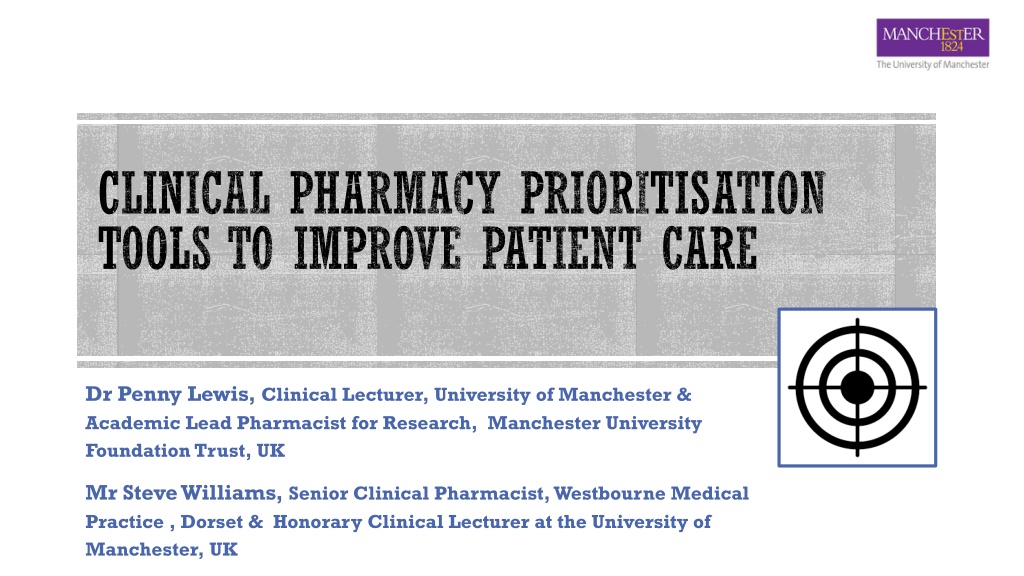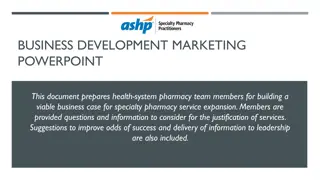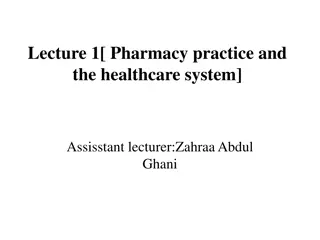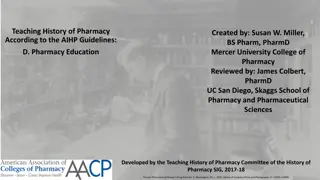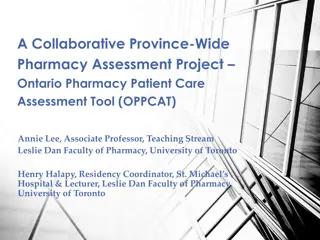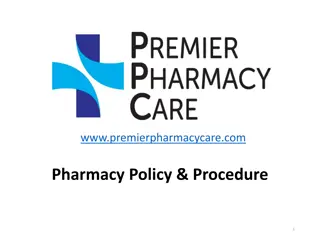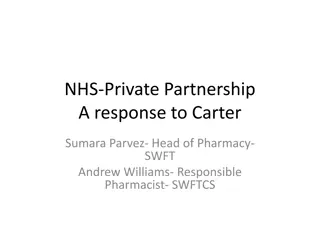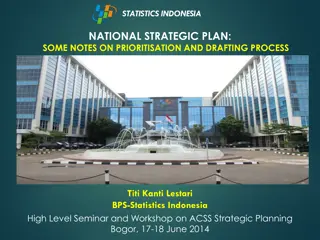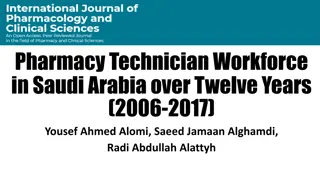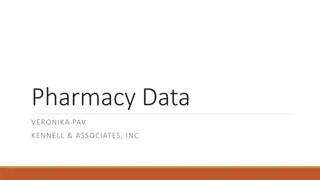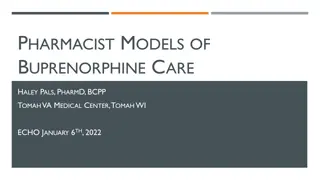Clinical Pharmacy Prioritisation Tools to Improve Patient Care Workshop
Explore the importance of prioritising pharmacy services, understand what factors make a patient complex or a priority, and learn about the development and implementation of effective prioritisation tools in clinical pharmacy practice. Expert insights from Dr. Penny Lewis and Mr. Steve Williams shed light on enhancing patient care through efficient resource allocation and proactive measures. Discover evidence-based strategies to optimize pharmacy services and enhance patient safety.
Download Presentation

Please find below an Image/Link to download the presentation.
The content on the website is provided AS IS for your information and personal use only. It may not be sold, licensed, or shared on other websites without obtaining consent from the author. Download presentation by click this link. If you encounter any issues during the download, it is possible that the publisher has removed the file from their server.
E N D
Presentation Transcript
CLINICAL PHARMACY PRIORITISATION TOOLS TO IMPROVE PATIENT CARE Dr Penny Lewis, Clinical Lecturer, University of Manchester & Academic Lead Pharmacist for Research, Manchester University Foundation Trust, UK Mr Steve Williams, Senior Clinical Pharmacist, Westbourne Medical Practice , Dorset & Honorary Clinical Lecturer at the University of Manchester, UK
WORKSHOP CONTENT Why prioritise? What is the current evidence? What makes a patient complex or a priority? What makes a good prioritisation tool? What factors should you consider when implementing a prioritisation tool?
Why Prioritise? Efficiency Safety Are we making the most of pharmacy resources including staff and experience? Is the traditional model of delivery working? Can we effectively respond to pressures on the system e.g. Covid 19, MR targets, 24/7 working? Pharmacists play key role in patient safety EQUIP found 1/10 hospital prescriptions contain an error1 Risk of ADEs if miss patients who need review Development of tools Acuity or prioritisation tools to target pharmacy services to those patients who would most benefit Locally developed systems 1. Ashcroft DM, Lewis PJ, Tully MP, Farragher TM, Taylor D, Wass V et al. Prevalence, Nature, Severity and Risk Factors for Prescribing Errors in Hospital Inpatients: Prospective Study in 20 UK Hospitals. Drug Safety 2015; 38(9):833-843.
POLL: HOW DO YOU DECIDE WHICH PATIENTS TO SEE FIRST? By speaking to nurses and/or doctors From previous pharmacist handover I see patients taking high risk medicines first By management choice to serve some units and not others By using a prioritisation tool I don t- I tend to start at bed one Other
Systematic Review Nineteen studies involving 17 risk assessment tools- included from around the world. Heterogeneous - targeting different patient groups and clinical settings Lack of agreement on tool components - include many different risk factors None measured impact on prescription errors or ADEs Alshakrah M, Steinke D, Lewis PJ. Patient prioritization for pharmaceutical care in hospital: A systematic review of assessment tools. Research in Social and Administrative Pharmacy 2019; 15(6):767-779. Perceived positive impact of risk assessment tools on patient care and pharmacy service provision.
National UK Survey 54% (n=70) of UK trusts and health boards have a tool or system for assigning clinical pharmacy services (RR of 76.5%,130/170) Red/highest priority reviewed daily, amber 48 - 72 hours, lowest risk reviewed less frequently or at discharge Local development or adapted from other hospitals Hospitals at various stages of development No standardised approach Little formal evaluation Abuzour A, Hoad-Reddick G, Shahid M, Steinke D, Tully M, Lewis PJ. Patient prioritisation for hospital pharmacy services: current approaches in the United Kingdom. European Journal of Hospital Pharmacy. Online First: 01 December 2020 Need for systematically developed, evidence-based tools in practice
Impetus for Tool Use What s become really apparent is that we are doing some patients a really significant disservice, because they re not getting enough time from us. So, this, to me, is less about stopping seeing people who don t need us, although I think that is important, it s more about making sure that we re seeing the people who really do need us.
Types of Tools Electronic Paper Predictive models Paper- electronic Naturalistic expert knowledge driven tools
WHAT FACTORS MAKE A PATIENT A PRIORITY FOR PHARMACY REVIEW? Please put your responses in the chat
Selection of tool components Specialty Local priorities Influences Skill mix Info availability
What makes a patient complex or a priority? International Delphi study including 33 experts and consensus reached on 92 components. Components grouped into demographic, clinical and medication components and condensed to 33 items and included in the first draft of the Adult Complexity Tool for Pharmaceutical Care (ACTPC) ACTPC tool stratifies patients into highly, moderately or least complex National Delphi study including 40 experts reach consensus on review frequency and experience of pharmacy practitioner at each level
THE ADULT COMPLEXITY TOOL FOR PHARMACEUTICAL CARE Adult complexity tool for pharmaceutical care (ACTPC-Form 1) Patient name: Diagnosis: Triage date/time: Patient hospital number: Adult complexity tool for pharmaceutical care (ACTPC-Form 2) Allergies: Pharmacist: Age: Weight: Ward: Patient name: Patient hospital number: Admission date/time: Diagnosis: Triage date/time: Ward: Pharmacist: Age: Weight: Criteria Scope Allergies: Red Criteria Descriptions Tick Criteria Scope Criteria Guidance Red, Amber and Green Criteria Descriptions Tick Criteria Age Weight Allergy Pregnancy Age 70 years old Patient has any of the following diseases and is in an unstable condition according to your clinical judgement: Extreme weight (frail/obese) < 50 KG / > 120 KG History of severe allergic reaction Pregnant or breast-feeding Demographic Criteria Priority Diseases Endocarditis Hyperthyroid crisis NSTEMI/STEMI Decompensated heart failure Parkinson disease Epilepsy Mental health conditions Myasthenia gravis G6PD deficiency Porphyria Patient has any of the following diseases and is in an unstable condition according to your clinical judgement: Patient has any of the following diseases and is in an unstable condition according to your clinical judgement: Endocarditis Hyperthyroid crisis Parkinson disease Epilepsy Mental health conditions Myasthenia gravis G6PD deficiency Patient has any of the following diseases but is in a stable condition according to your clinical judgement: Endocarditis Hyperthyroid crisis Parkinson disease Epilepsy Mental health conditions Myasthenia gravis G6PD deficiency Patient has any of the following diseases and is in anunstable condition according to your clinical judgement: Meningitis Sepsis HIV Patient has any of the following diseases but is in a stable condition according to your clinical judgement: Meningitis Sepsis HIV Stage 3: a rise in creatinine 3 times the baseline value Stage 2: a rise in creatinine from 2 to 2.9 times the baseline value Stage 1: a rise in creatinine from 1.5 to 1.9 times the baseline value Severely decreased: GFR 29 ml/minute This tool ACTPC-Form1 (With red criteria only) for use directly on admission at ADULT ACUTE MEDICAL UNIT. NSTEMI/STEMI Decompensated heart failure Porphyria Priority Diseases Infectious Diseases NSTEMI/STEMI Decompensated heart failure Porphyria Gastric absorption problems Patients who meet any of these criteria/identified as clinically unstable are immediately rated as RED and are a high priority for both initial medicines reconciliation and continuing clinical review. Meningitis Sepsis HIV Tuberculosis(TB) Clinical Related Criteria Acute Kidney Injury Tuberculosis(TB) Infectious Diseases Stage 3: a rise in creatinine 3 times the baseline value The priority level can be changed at any time if the patient s circumstances change. Tuberculosis(TB) Clinical Related Criteria Acute Kidney Injury Chronic Kidney Disease Severely decreased: GFR 29 ml/minute Patients who have any red criteria can be downgraded depending on clinical condition and/or medication changes by using ACTPC-Form2 Chronic Kidney Disease Moderately to severely decreased: GFR 30-44 ml/minute Mildly to moderately decreased: GFR 45-59 ml/minute Hepatic Impairment (LFT'S) Severe hepatic impairment (LFT'S 3 times the upper limit of normal) Hepatic Impairment (LFT'S) Severe hepatic impairment (LFT'S 3 times the upper limit of normal) Moderate hepatic impairment (LFT'S < 3 times the upper limit of normal) Patient had at least one admission in the last month. (Discharged < 30 days ago) Patient has any of the following characteristics: Uncontrolled pain National early warning score 5 Abnormal laboratory results NOT related to medication (Excluding renal and liver ) Hospitalisation An organ transplant An organ transplant Miscellaneous Miscellaneous Palliative care Nil by mouth or has swallowing difficulties High risk medication and medicines requiring TDM list** Prescribed 15 regular medicines with complex regimen e.g. drug-drug or drug-disease interactions. Anticoagulants: Heparin, LMWH, Warfarin, NOACs (Apixaban, Dabigatran, Rivaroxaban, Edoxaban), Anti-Psychotics: Clozapine, Depot Injections Chemotherapy Antiepileptic medication: Sodium Valproate, Lamotrigine, Levetiracetam, Phenytoin Antiretrovirals for HIV and Hepatitis C: Darunavir, Emtricitabine, Lamivudine, Tenofovir Immunosuppressants: Azathioprine, Cyclosporine, Mercaptopurine, Mexotrexate, Mycophenolate, Tacrolimus Prescribed 15 regular medicines with complex regimen e.g. drug-drug or drug-disease interactions. Polypharmacy Prescribed 15 regular medicines without complex regimen e.g. No drug-drug or drug-disease interactions Polypharmacy Prescribed < 15 regular medicines with complex regimen e.g. drug-drug or drug-disease interactions Prescribed any high risk medicines** or medicines requiring TDM** with documented or suspected toxic or subtherapeutic effect. Prescribed any high risk medicines** or medicines requiring TDM** without documented or suspected toxic or subtherapeutic effect. Documented or suspected toxic or subtherapeutic effect due to drug interactions. No documented or suspected toxic or subtherapeutic effect due to drug interactions. Patient admitted due to an adverse drug reaction Prolonged QT secondary to medicines** Falls secondary to medicines** Prescribed any high risk medicines** or medicines requiring TDM** with documented or suspected toxic or subtherapeutic effect. Medication Risk Medication Risk Medication Related Criteria Treatment Interactions Documented or suspected toxic or subtherapeutic effect due to drug interactions. Narrow Therapeutic Index: Aminophylline, Digoxin, Lithium, Phenytoin, Theophylline Opiates & Substance Misuse: Buprenorphine, Naloxone, Fentanyl , Morphine, Methadone, Oxycodone Treatment Interactions Medication Related Criteria Drug related problems Abnormal laboratory results related to medication or if dose adjustment/omissions are required Subcutaneous Syringe Intravenous glucose> 20% Restricted antibiotics** Continuous IV infusion including electrolytes Drug related problems Patient admitted due to an adverse drug reaction Miscellaneous Parkinson's disease medication: Co-Beneldopa , Co- careldopa, Entacapone , Rasagiline IV Antibiotics: Vancomycin, Gentamicin, Amikacin, Tobramycin, Rifampicin, Erythromycin, Clarithromycin. IV Inotropes: e.g. Milrinone , Dopamine, Dobutamine, Isoprenaline, Vasopressors Antifungals: Amphotericin, High dose or extended course duration of Triazole Total parenteral nutrition (TPN), Imunoglobulins, Insulin Corticosteroid, Intravenous beta-Blocker Risk level Complexity level Pharmacist practitioner level Criteria Range Abnormal laboratory results related to medication or if dose adjustment/omissions are required The patient has one or more red criteria Miscellaneous Experienced clinical pharmacist Highly complex- should be seen in the first 6-12 hours of admission then daily High risk The patient has One or more amber criteria Clinical pharmacist Moderately complex- should be seen in the first 24 hours of admission then daily Moderate risk Pharmacist Comments: Complexity level Pharmacist level Criteria Range Risk level The patient stable with no acute issues AND he/she DOES NOT have any red or amber criteria The patient has one or more red criteria Highly complex- should be seen in the first 6-12 hours of admission then daily Alshakrah MA, Steinke DT, Tully MP, Abuzour AS, Williams SD, Lewis PJ. Development of the adult complexity tool for pharmaceutical care (ACTPC) in hospital: a modified Delphi study. Research in Social and Administrative Pharmacy 2021; online first 14 Feb. Clinical pharmacist Least complex- should be seen in the first 24 hours of admission then twice weekly Experienced clinical pharmacist Low risk High risk In the absence of specific example relevant to each individual criteria, allocate the patient based on clinical judgement. The priority level can be changed at any time if the patient s circumstances change. Overall assessment of pharmaceutical care complexity: High Low or Moderate Overall assessment of pharmaceutical care complexity: Low Moderate High Date: Date: Date: Date: Date: Date: ACTPC-1 ** Provided on the back of this tool. ACTPC-2
Tool Benefits Surveillance and oversight of pharmacy service demand - facilitating the management of staffing and efficient use of resources Ability to assign appropriately experienced pharmacist As well as individual pharmacists managing their own workload it lets the team leaders manage the work of the whole team and allows them to target tasks to individuals based on individuals' knowledge and skills As manager, to be able to look through and see which areas may be struggling for whatever reason, be able to approach the team and find out what's happened or what extra help they need as well. So we've got much better oversight. We don't normally go to orthopaedics but there's a new patient on the orthopaedic ward that's on high risk drugs, somebody go and sort that out.
Tool Benefits Enhanced continuity of care Instilled confidence Learning opportunity it lets individuals feel confident they've done the things they need to do in the order they need to do them. So the days of when you turned up on a ward and had to go around every bed just to find the things you need to do are gone now. So you can confidently not go and see patients because nothing's changed. A pharmacist would go in totally na ve to what the care issues were and now, because everything is logged, you know the patient red, amber or green, you can see from the comments column what made them that status, the continuity of care is, I would say, is far improved. And also gives them [pharmacists] responsibility of making sure that they discuss the more unwell patients, or the higher priority patients, that they discuss them with somebody more senior
Tool Drawbacks Implementation problems - lack of pharmacist uptake Potential to miss out on wider pharmaceutical issues So a patient that's had their meds sorted out on admission and everything's gone green gets left behind and the opportunity for a pharmacist to have a conversation with them and suddenly realise there's some issues around their concordance and things like that is gone because we've deselected them as being high risk. you have, pharmacists are generally quite risk averse. So we do have pharmacists that say I couldn't possibly leave this patient from Thursday to Friday but will leave them at the weekend.
Tool Drawbacks Paper-based systems (vs electronic systems) Tool sensitivity Risk of deskilling In the Epic system, you can get a list of patients that are on high risk medicines, but we found that that wasn t very effective because so many patients are on high risk medicines, so that it actually doesn t help you target patients, it s too crude. the difficulties are that we don't have an electronic system at the moment, there isn't a way of identifying patients that we are potentially missing. So if a new medication has been prescribed, there isn't a way of that being flagged up to us, like it would be in an electronic system.
Top Tips for Tool Use Explore current tools Adapt tools - ensuring fit local context Include engagement from the frontline team Time effective and clear Allow for professional judgement Consider at implementation of EPR and EP Allow for human contact Evaluate
Workshop reflection How do you currently prioritise patients for pharmaceutical care in your organisation? What are the advantages and disadvantages of your current approach? What would you want a prioritisation tool to achieve? What do you have in your organisation that could help you implement a prioritisation tool? What one action are you going to complete after attending this session?
Three take home messages 1. Use the evidence when considering tool implementation 2. Engage frontline staff in the development and implementation of prioritisation tools 3. Monitor an evaluate the impact of changes
Questions Please raise your hand or use the chat function to ask questions
THANKS FOR LISTENING Please email questions to penny.lewis@manchester.ac.uk or steven.williams@dorsetgp.nhs.uk or tweet @DrPennyLewis @STEVECHEMIST
